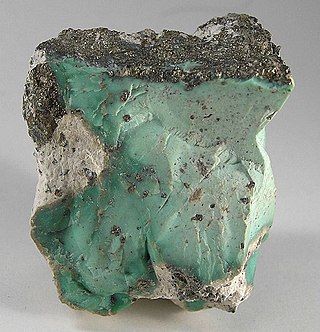
Variscite is a hydrated aluminium phosphate mineral (AlPO4·2H2O). It is a relatively rare phosphate mineral. It is sometimes confused with turquoise; however, variscite is usually greener in color. The green color results from the presence of small amounts of trivalent chromium (Cr3+
).

Wardite is a hydrous sodium aluminium phosphate hydroxide mineral with formula: NaAl3(PO4)2(OH)4·2(H2O). Wardite is of interest for its rare crystallography. It crystallizes in the tetragonal trapezohedral class and is one of only a few minerals in that class. Wardite forms vitreous green to bluish green to white to colorless crystals, masses, and fibrous encrustations. It has a Mohs hardness of 5 and a specific gravity of 2.81–2.87.
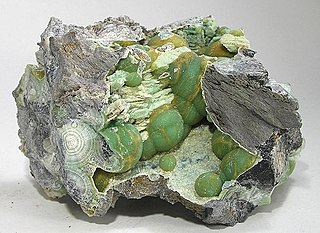
Wavellite is an aluminium basic phosphate mineral with formula Al3(PO4)2(OH, F)3·5H2O. Distinct crystals are rare, and it normally occurs as translucent green radial or spherical clusters.

Lithiophilite is a mineral containing the element lithium. It is lithium manganese(II) phosphate with chemical formula LiMnPO4. It occurs in pegmatites often associated with triphylite, the iron end member in a solid solution series. The mineral with intermediate composition is known as sicklerite and has the chemical formula Li(Mn,Fe)PO4). The name lithiophilite is derived from the Greek philos (φιλός) "friend", as lithiophilite is usually found with lithium.
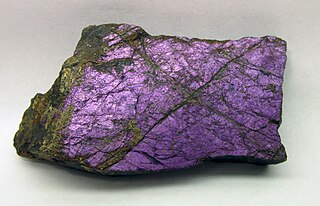
Purpurite is a manganese phosphate mineral with the formula MnPO4, with varying amounts of iron depending upon its source. It occurs in color ranges from brownish black via purple and violet to dark red.

Brushite is a phosphate mineral with the chemical formula CaHPO4·2H2O. Crystals of the pure compound belong to the monoclinic space group C2/c and are colorless. It is the phosphate analogue of the arsenate pharmacolite.

Triploidite is an uncommon manganese iron phosphate mineral with formula: (Mn, Fe)2PO4OH. It crystallizes in the monoclinic crystal system and typically occurs as elongated and striated slender prisms which may be columnar to fibrous. Its crystals may be pinkish to yellowish brown or red-orange.
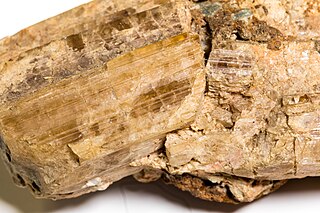
Wagnerite is a mineral, a combined phosphate and fluoride of iron and magnesium, with the formula (Mg,Fe2+)2PO4F. It occurs in pegmatite associated with other phosphate minerals. It is named after Franz Michael von Wagner (1768–1851), a German mining official in Munich.
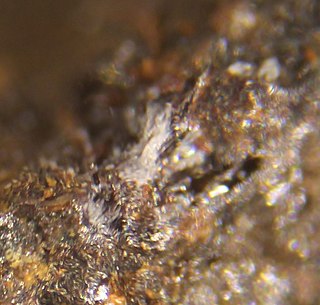
Brianite is a phosphate mineral with the chemical formula Na2CaMg(PO4)2. It was first identified in an iron meteorite. This mineral is named after Brian Harold Mason (1917–2009), a pioneer in meteoritics.

Eosphorite is a brown (occasionally pink) manganese hydrous phosphate mineral with chemical formula: MnAl(PO4)(OH)2·H2O. It is used as a gemstone.

Santabarbaraite is an amorphous ferric hydroxy phosphate mineral hydrate that was discovered in Tuscany, Italy during 2000. It also can be found in Victoria, Australia and Lake Baikal, Siberia.

Svanbergite is a colorless, yellow or reddish mineral with the chemical formula SrAl3(PO4)(SO4)(OH)6. It has rhombohedral crystals.

Berlinite (aluminium phosphate, chemical formula AlPO4 or Al(PO4)) is a rare high-temperature hydrothermal or metasomatic phosphate mineral. It has the same crystal structure as quartz with a low temperature polytype isostructural with α–quartz and a high temperature polytype isostructural with β–quartz. Berlinite can vary from colorless to greyish or pale pink and has translucent crystals.
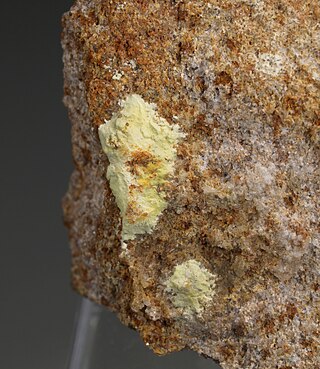
Coconinoite is a uranium ore that was discovered in Coconino County, Arizona. It is a phosphate mineral; or uranyl phosphate mineral along with other subclass uranium U6+ minerals like blatonite, boltwoodite, metazeunerite and rutherfordine.

Beraunite is an iron phosphate mineral. It was first described by August Breithaupt for an occurrence in Beraun currently in the Czech Republic. Beraunite occurs as a secondary mineral in iron ore deposits, and as an alteration product of primary phosphate minerals in granite pegmatites.

Hureaulite is a manganese phosphate with the formula Mn2+5(PO3OH)2(PO4)2·4H2O. It was discovered in 1825 and named in 1826 for the type locality, Les Hureaux, Saint-Sylvestre, Haute-Vienne, Limousin, France. It is sometimes written as huréaulite, but the IMA does not recommend this for English language text.

Gormanite is a phosphate mineral with the formula (Fe,Mg)3Al4(PO4)4(OH)6·2H2O. It was named after the University of Toronto professor Donald Herbert Gorman (1922-2020).

Minyulite is a rare phosphate mineral with a chemical formula of KAl2(PO4)2F·4(H2O).

Ludlamite is a rare phosphate mineral with chemical formula (Fe,Mn,Mg)3(PO4)2·4H2O. It was first described in 1877 for an occurrence in Wheal Jane mine in Cornwall, England and named for English mineralogist Henry Ludlam (1824–1880).
Lithiophosphate is a natural form of (pure) lithium orthophosphate. It is an exceedingly rare mineral, occurring in some special types of pegmatites.



















